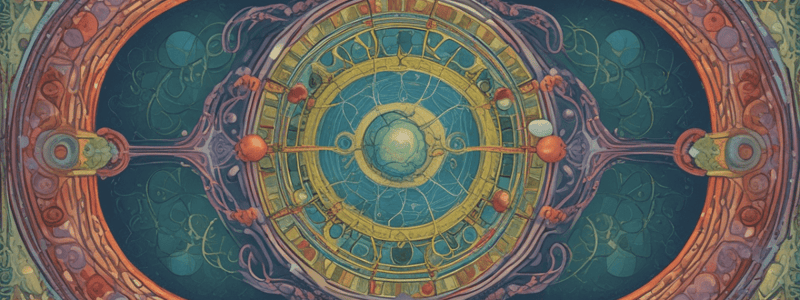Podcast
Questions and Answers
What is the main function of the G2 phase in the cell cycle?
What is the main function of the G2 phase in the cell cycle?
- Preparation for cell division (correct)
- Preparation for DNA replication
- Repair of damaged DNA
- Synthesis of proteins
What is the location of genes for the ribosomal subunits?
What is the location of genes for the ribosomal subunits?
- Cytoplasm
- Nucleolus (correct)
- Nuclear envelope
- Nucleoplasm
What is the genetic material used by retroviruses?
What is the genetic material used by retroviruses?
- Lipid
- Protein
- RNA (correct)
- DNA
What is the result of a retrovirus infecting a host cell?
What is the result of a retrovirus infecting a host cell?
Which of the following is NOT involved in the processing and modification of rRNA?
Which of the following is NOT involved in the processing and modification of rRNA?
What is the likely effect of a virus targeting the nucleolus and its components?
What is the likely effect of a virus targeting the nucleolus and its components?
What is the site of full assembly of mature ribosomes?
What is the site of full assembly of mature ribosomes?
What is the effect of viral infection on the nucleolus?
What is the effect of viral infection on the nucleolus?
What is the nucleolus composed of?
What is the nucleolus composed of?
What is a possible outcome of a retrovirus altering the cell cycle?
What is a possible outcome of a retrovirus altering the cell cycle?
What do retroviruses use as part of their own replication process?
What do retroviruses use as part of their own replication process?
What diseases are caused by retroviruses?
What diseases are caused by retroviruses?
What is the role of RNA polymerase I in the synthesis of ribosomal subunits?
What is the role of RNA polymerase I in the synthesis of ribosomal subunits?
What is exported from the nucleus through nuclear pores?
What is exported from the nucleus through nuclear pores?
What is the primary function of the G1 phase in the cell cycle?
What is the primary function of the G1 phase in the cell cycle?
During which phase of the cell cycle is chromosome replication initiated?
During which phase of the cell cycle is chromosome replication initiated?
What is the duration of the mitotic phase in rapidly dividing cells?
What is the duration of the mitotic phase in rapidly dividing cells?
What occurs during the M phase of the cell cycle?
What occurs during the M phase of the cell cycle?
What is the purpose of the reorganization of cytoplasmic organelles before entering the mitotic cycle?
What is the purpose of the reorganization of cytoplasmic organelles before entering the mitotic cycle?
What is the result of chromosome replication during the S phase?
What is the result of chromosome replication during the S phase?
What is the significance of the S phase in the cell cycle?
What is the significance of the S phase in the cell cycle?
What is the reason for the intense basophilia of nucleoli?
What is the reason for the intense basophilia of nucleoli?
What is the site of ribosomal RNA synthesis and ribosomal subunit assembly?
What is the site of ribosomal RNA synthesis and ribosomal subunit assembly?
What is the characteristic of the fibrillar and granular subregions of the nucleolus?
What is the characteristic of the fibrillar and granular subregions of the nucleolus?
What is the fate of processed rRNA in the nucleolus?
What is the fate of processed rRNA in the nucleolus?
What is the composition of the nucleolus?
What is the composition of the nucleolus?
What is the characteristic of euchromatin in an active nucleus?
What is the characteristic of euchromatin in an active nucleus?
What is the role of nuclear pores in the nucleolus?
What is the role of nuclear pores in the nucleolus?
What is the characteristic of heterochromatin in an active nucleus?
What is the characteristic of heterochromatin in an active nucleus?
What is the organization of chromosomal regions with the genes for rRNA?
What is the organization of chromosomal regions with the genes for rRNA?
Flashcards are hidden until you start studying
Study Notes
Viruses and the Nucleolus
- Viruses may target the nucleolus to facilitate viral transcription and translation, and alter the cell cycle to promote viral replication.
- Retroviruses, a type of virus that uses RNA as its genetic material, make a DNA copy of its genome that is inserted into the host cell's DNA.
- Retroviruses can cause human diseases such as some forms of cancer and AIDS.
Cell Cycle
- The cell cycle consists of G1, S, G2, and M phases.
- G1 phase is the longest and most variable phase, during which the cell accumulates nutrients, synthesizes RNA and proteins necessary for DNA synthesis, and prepares for cell division.
- S phase involves replication of DNA, including duplication of DNA and formation of new chromatids.
- G2 phase involves preparation for cell division, examination of replicated DNA, reorganization of cytoplasmic organelles, and can last around 1 hour.
- M phase involves mitosis, which takes place in several stages, including karyokinesis (division of the nucleus) and cytokinesis (division of the cell).
The Nucleolus
- The nucleolus is a spherical, basophilic subdomain of nuclei in cells, actively making proteins.
- It is composed of fibrillar and granular subregions with different staining characteristics that reflect stages of rRNA maturation.
- Genes for ribosomal subunits are localized in the interstices of the nucleolus and are transcribed by RNA polymerase I.
- rRNA is processed in the nucleolus, quickly associated with ribosomal proteins, and exported to the cytoplasm through nuclear pores.
Studying That Suits You
Use AI to generate personalized quizzes and flashcards to suit your learning preferences.




